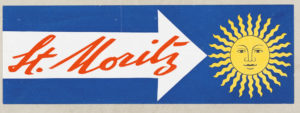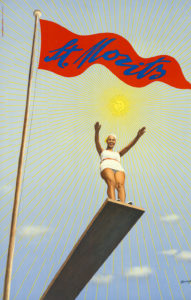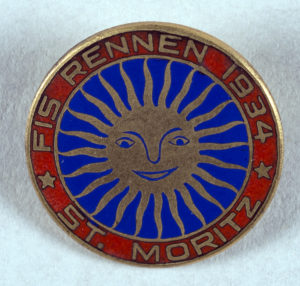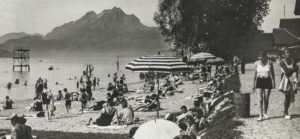
The Sun of St. Moritz
The sun and lettering in the design of the resort town of St. Moritz is the oldest still-used tourism trademark in the world. The symbol and logo were created in 1932 by Zurich graphic designer Walter Herdeg.
High up on the springboard, the sporty model is smiling down at the photographer’s camera. Even the sun shining out over the whole poster in a blue sky is smiling. A red banner with a blue St. Moritz inscription is waving on a flagpole in the foreground, also depicted from far below. The poster by 26-year-old Zurich graphic designer Walter Herdeg promises light, air, water and physical activity in the alpine summer of the no longer carefree year of 1934. It is not just the sporty, monumental image of a young sun-tanned woman in a white bathing suit that is so modern, but also the innovative use of a photographic template and the special poster printing technique.
As for the model? Wouldn’t we like to find out who the high diver posing here is? We have a hunch – any further information is welcome.
Walter Herdeg (1908–1995), co-founder and editor of Graphis, the trilingual trade magazine first published in 1944, worked almost exclusively for the St. Moritz Tourist Board from 1932 to 1938. During this time he not only developed the oldest tourist trademark still in use today, but also created groundbreaking methods for designing posters and brochures by combining photographic, graphic and typographic elements. Almost at the same time as Herbert Matter, the other Swiss photo poster pioneer.
Herdeg had the poster for the 1934 summer season printed at the Graphische Anstalt J. E. Wolfensberger. The lithographic printing company, which specialised in the printing of high-quality posters and art reproductions, worked together closely with the Orell Füssli printing company. In addition to lithography, even back then Orell Füssli offered both offset and intaglio printing. For the transfer of photographic elements, 300-kilogramme stones were each transported by three printers via lorry from “Wolfsberg” to Orell Füssli, where they were prepared for use. This technique made it possible to create very subtle colour variations during printing. The long-forgotten combination of hand lithography and photochromy was a true speciality of the two complementary Zurich-based quality printing companies.

Walter Herdeg. Tourism poster for the summer season in St. Moritz. Zurich: Graphische Anstalt J. E. Wolfensberger, 1934. Lithograph and photochrome. Photo: Swiss National Museum

Walter Herdeg and his wife Kathleen in Grindelwald, 1940. Photo: Swiss National Museum

Walter Herdeg’s trademark symbol used on a pin for the 1934 FIS races. Photo: Swiss National Museum



